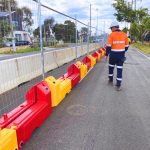Australia’s most cost-savvy tradies are saving thousands of dollars every year thanks to a few simple power-tool maintenance hacks.
One of the worst parts of being a tradie is that sinking feeling when one of your prized power tools packs it in, wasting the day as you cannot work while sourcing an urgent repair or replacement.
According to data from the Australian Bureau of Statistics (ABS), the average cost of materials and equipment for construction workers in Australia is around $20,000 annually.
But some simple tricks of the trade can help to get several years more life out of costly work equipment that would otherwise cost hundreds, if not thousands, of dollars a year to replace.
So whether it’s buying new parts or replacing entire units, the job site’s most hard-yakka tools can have their life expectancy extended years, even decades, all thanks to a bit of tradie TLC.
So get those dirty, damp, neglected moneymakers out of their toolbags and get ready to do some cleaning as Build-it reveals the best way to keep your power tools ticking.
Power connections
High-frequency use means power tools receive wear and tear in many different ways, but one of the most common issues is impairing their power supply.
For plug-in tools, damaging the power cord by tightly wrapping it around the tools after use or tugging while trying to unravel it can harm the cable attachments.
While plugged in, sharp pulls at the cord are also best avoided as they can lead to bent connector progs on the plug.
Batteries can be even more temperamental, often suffering from various kinds of dirt and debris which can scratch or damage the connectors or charging mechanisms.
To avoid this, ensure battery packs are packed and kept securely in their case or charging unit when unused.
Blades and edges
A sharp edge or blade is better for precise and efficient cutting and helps strengthen the lifespan of the tool’s electric motor components.
By allowing blades and edges to soften, extra strain is placed on the unit and its motor, which can lead to irreparable damage to the tool’s mechanics.
Ensure you sharpen blades if possible or replace them at the earliest sign of deterioration.
A water disbursement or lubricating spray such as WD-40 Multi-Use Product can even diminish wear on the blades by reducing friction as it moves.
Rotating blades or moving sharp edges can fall victim to blockages from cutting dust or general work-site dirt and grim.
A wire brush or pipe cleaner can help remove debris slowing the tool, while a blast of compressed air or liquid can remove the most hard-to-reach blockages.
Mechanical malfunctions
The mechanical components of a power tool are one of the easiest parts to damage but one of the most expensive to replace.
Keeping these parts clean and free from debris and dirt is essential.
Brushing the exterior of your tools down and using small instruments like a toothbrush or wire brush to reach any half-enclosed electrical components will help lengthen the life of your equipment.
Ensure your tools run smoothly by spraying inside moving metal parts with WD-40 Multi-Use Product.
Protection and storage
One of the easiest ways you can protect your tools from harm in the first place is by ensuring they are packed away correctly at the end of a hard shift.
While most tradies try to skip out on the extra five minutes it takes to adequately protect and store their most expensive tool, staying behind and doing so could save them days worth of work in the long run.
Invest in high-quality toolboxes and carrying cases and ensure multiple power tools are secured to prevent them from hitting each other or the work vehicle and creating unneeded dings and dents.
Ensure dirt, debris and grime are either washed or wiped away at the end of every shift.
Give the tools a quick blast with WD-40 Multi-Use Product to add an extra layer of post-work protection against rust and corrosion, which will help metal components and sharp edges last longer.








